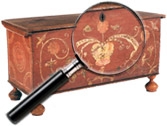|
|
Cartouche – Definition
The decorative arts world has many “squishy” and vague vocabulary words, but few are “squishier” and vaguer than cartouche. Originally, the term comes from Egyptology and is used to describe a oval enclosing hieroglyphics and having a horizontal line at one end. (The line denotes royalty.) The oval had significance not unlike that of a closed circle, in that it was believed that an oval around a person’s name provided protection [...] Click here to continue reading.
Estate of Peter L. Rosenberg of Vallin Galleries, Wilton Connecticut
Discerning collectors, dealers, and museum curators of Asian art regularly made pilgrimages to a charming 18th century saltbox home in Wilton, Connecticut: Vallin Galleries. Owned and operated by Peter L. Rosenberg for nearly thirty years until his sudden death in December of 2013, Vallin Galleries was widely regarded as an outstanding source for the best of Asian art and antiques. Skinner is proud to [...] Click here to continue reading.
Captain Hall J. Tibbits (American, 1797 to 1872)
This article about the life and career of Captain Tibbits by Eric C. Rodenberg appeared on the 4 November 2013 front page of Antique Week’s National Section. Used by permission. http://www.antiqueweek.com.
1800s Sea Captain’s Life Told Through Collection
At 6 foot, 4 inches tall and “powerfully built” Capt. Hall Jackson Tibbits would brook no foolishness.
After his “religious principles” were violated by passengers dancing on [...] Click here to continue reading.
Coca-Cola
Dr. John Stith Pemberton (1831 to 1888), an Atlanta pharmacist, invented Coca-Cola in 1886. A year earlier, he had introduced an alcoholic beverage called “Pemberton’s French wine coca”, but the temperance movement was then gathering momentum in the United States, prompting him to develop an alcohol-free product. Pemberton mixed a combination of lime, cinnamon, coca leaves, and kola nuts to make the famous beverage. When Coca-Cola was first introduced, the syrup was mixed [...] Click here to continue reading.
Blenko Glass
Art Glass of the Atomic Age 1950-1960
William Blenko had success as a manufacturer of stained glass. While that business dried up with the arrival of the Depression, by 1932 his tableware was on display at Macy’s. Today, collectors look for Blenko’s signature pieces in exaggerated sizes, bold shapes, and brilliant colors.
Brief History of Blenko Glass Born in 1853, William J. Blenko began learning his trade at the age of 13 [...] Click here to continue reading.
Canning Jars
Canning jars, also called fruit jars, because early versions were primarily used for fruit, or Mason jars, after the best-known manufacturer, are one of those technological advances that have become so ubiquitous we’ve forgotten just how revolutionary the development of food preservation really was. Many of the greatest empires, events and discoveries of the 19th century were largely aided by the development of the canning process. Supplying armies, expeditions and explorations was [...] Click here to continue reading.
Bakelite
Scandal & the Story of Bakelite Bakelite hit the market in 1907, heralding the arrival of the modern plastics industry. Bakelite was the first completely man made plastic, as until then, plastics such as celluloid, casein, and Gutta-Percha all had as a base a natural material. It was developed by Belgian-born chemist Dr. Leo Hendrick Baekeland who started his firm General Bakelite Company to produce the phenolic resin type plastic. Bakelite was inexpensive [...] Click here to continue reading.
Pyroglaze Decorated Milk Bottles A Hertzler’s Dairy pyroglazed milk bottle from Elizabethtown PA, p4A item D9691542
Pyroglazing, or pyro for short, is a type of silk screening decoration introduced in the early 1930s to put colored labels on bottles. Pigments were fused to the glass during manufacture to create colored text and graphic designs. The process was quicker and more cost effective than using molds needed for embossing.
Thatcher Manufacturing referred to the [...] Click here to continue reading.
Ex Collection of Richard and Joane Smith
Richard Flanders Smith and his wife Joane both grew up in New England, Richard in Massachusetts and Joane in Connecticut. They both had a keen interest in art and design and attended the Yale University School of Fine Arts where they met as 3rd year art students. The couple sent each other one handmade drawn or painted card after card as their romance blossomed. After eloping in [...] Click here to continue reading.
Note: Chinese names of cities and individuals appear first in Pinyin. Traditional or Wade-Giles versions, where available, follow in parenthesis.
The Golden Years of the Qing Dynasty: The Ming Dynasty Crumbles
By the middle of the 16th century, the once brilliant Ming Dynasty (1368-1644) was in decline. Beset by external threats in the form of piracy on the coast and the aggressive Mongol nomads to the north, conditions were made worse by inept [...] Click here to continue reading.
|
Recent Articles
- Charles Alfred Meurer – American Artist & Tromp L’Oeil Artist
- Sendak, Maurice – American Artist & Writer
- Godie, Lee – American Artist
- Davis, Vestie – American Artist
- Bartlett, Morton – American Artist
- Mackintosh, Dwight – American Artist
- Evans, Minnie Jones – African-American Artist
- Mumma, Ed (Mr. Eddy) – American Artist
- Nice, Don – American Artist
- Savitsky, John (Jack) – American Artist
- Gordon, Harold Theodore (Ted) – American Artist
- Dial, Thornton – African-American Artist
- Doyle Sam – American Artist
- Johnson, Lester Frederick – American Artist
- Finster, Howard – American Artist
|
|
